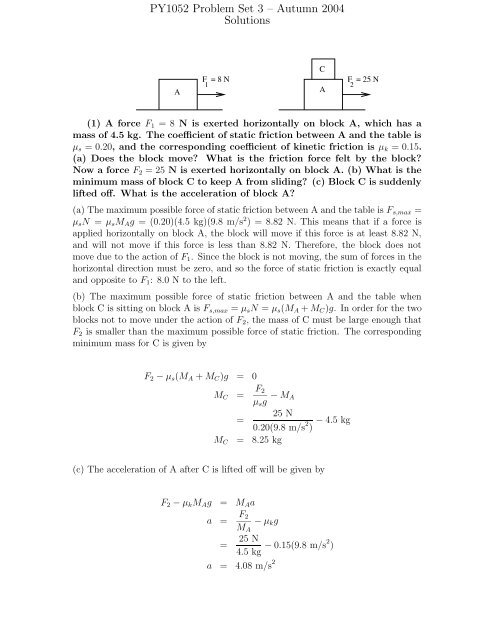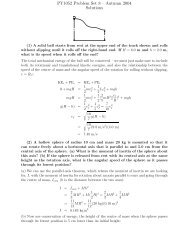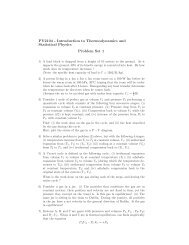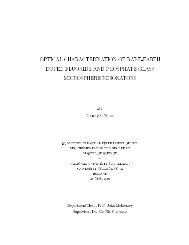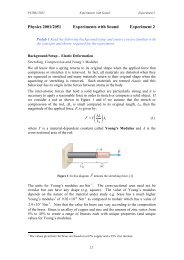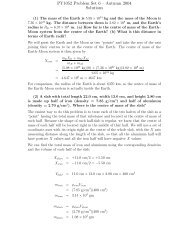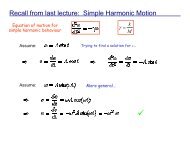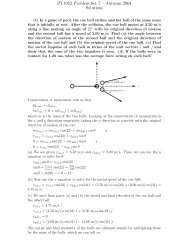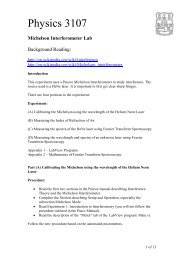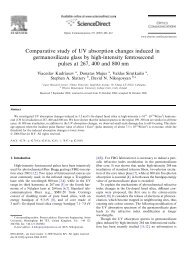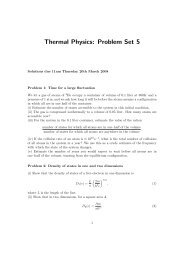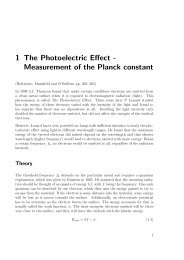PY1052 Problem Set 3 â Autumn 2004 Solutions
PY1052 Problem Set 3 â Autumn 2004 Solutions
PY1052 Problem Set 3 â Autumn 2004 Solutions
You also want an ePaper? Increase the reach of your titles
YUMPU automatically turns print PDFs into web optimized ePapers that Google loves.
<strong>PY1052</strong> <strong>Problem</strong> <strong>Set</strong> 3 – <strong>Autumn</strong> <strong>2004</strong><strong>Solutions</strong>CF = 8 NF = 25 N1 2AA(1) A force F 1 = 8 N is exerted horizontally on block A, which has amass of 4.5 kg. The coefficient of static friction between A and the table isµ s = 0.20, and the corresponding coefficient of kinetic friction is µ k = 0.15.(a) Does the block move? What is the friction force felt by the block?Now a force F 2 = 25 N is exerted horizontally on block A. (b) What is theminimum mass of block C to keep A from sliding? (c) Block C is suddenlylifted off. What is the acceleration of block A?(a) The maximum possible force of static friction between A and the table is F s,max =µ s N = µ s M A g = (0.20)(4.5 kg)(9.8 m/s 2 ) = 8.82 N. This means that if a force isapplied horizontally on block A, the block will move if this force is at least 8.82 N,and will not move if this force is less than 8.82 N. Therefore, the block does notmove due to the action of F 1 . Since the block is not moving, the sum of forces in thehorizontal direction must be zero, and so the force of static friction is exactly equaland opposite to F 1 : 8.0 N to the left.(b) The maximum possible force of static friction between A and the table whenblock C is sitting on block A is F s,max = µ s N = µ s (M A + M C )g. In order for the twoblocks not to move under the action of F 2 , the mass of C must be large enough thatF 2 is smaller than the maximum possible force of static friction. The correspondingminimum mass for C is given byF 2 − µ s (M A + M C )g = 0M C = F 2µ s g − M A=25 N0.20(9.8 m/s 2 − 4.5 kg)M C = 8.25 kg(c) The acceleration of A after C is lifted off will be given byF 2 − µ k M A g = M A aa = F 2M A− µ k g= 25 N4.5 kg − 0.15(9.8 m/s2 )a = 4.08 m/s 2
(2) A 110-gram hockey puck sent sliding over ice with an initial speedof 6.0 m/s is stopped in 15 m by the frictional force on it from the ice. (a)What is the magnitude of the frictional force on the ice? (b) What is thecoefficient of kinetic friction between the puck and the ice?(a) Since the frictional force is constant, the acceleration will be constant, and we canuse our equations for constant acceleration. We know the initial velocity (6.0 m/s),the final velocity (0 m/s) and the distance travelled (15 m). Therefore,v 2 = v 2 o + 2a(x − x o )a = v2 −v 2 o2(x−x o)a = 02 −6.0 m/s 22(15 m)= −1.2 m/s 2The magnitude of the frictional force will beF k = m|a| = (0.110 kg)(1.2 m/s 2 ) = 0.132 N(b) The frictional force is given byF = µ k NIn the vertical direction, there are two forces, the puck’s weight and the normal force,which must add to zero:N − mg = 0 −→ N = mgTherefore,F = µ k N = µ k mgµ k = F mg = mamg = a g=1.2 m/s29.8 m/s 2 = 0.12(3) A pig slides down a 35 ◦ incline in twice the time that it would takehim to slide down a frictionless 35 ◦ incline. What is the coefficient ofkinetic friction between the pig and the incline?There are three forces acting on the pig: the normal force, its weight and the frictionforce. The normal force N is purely perpendicular to the ramp, the frictional forceF k is purely up the ramp and the weight has a component mg sin(35) down the rampand mg cos(35) perpendicular to the ramp, opposite the normal force. There is noacceleration perpendicular to the ramp, and we’ll call the acceleration down the rampa f (for acceleration with friction):N − mg cos(35) = 0 perpendicular to the rampmg sin(35) − F k = ma f along the rampmg sin(35) − µ k N = ma fSolving for N in the first equation, plugging into the third equation and solving fora f yieldsa f = g(sin(35) − µ k cos(35))If there is no friction, this is equivalent to µ k = 0, and the corresponding accelerationa nf will bea nf = g sin(35)
Now use these two accelerations to find the time for the pig to slide down the rampof length x with and without friction, t f and t nf :x = v 0 t + 1 2 at2 = 1 2 at2 v 0 = 0x = 1 2 a ft 2 f = 1 2 a nft 2 nfBut we are told that t f = 2t nf :12 a f[2t nf ] 2 = 1 2 a nft 2 nf4a f = a nf4g(sin(35) − µ k cos(35)) = g sin(35)4µ k g cos(35) = 3g sin(35)µ k = 3 tan(35) = 0.524(4) A dart is thrown horizontally with an initial speed of 10 m/s towardthe bull’s eye on a dart board. It hits at a point directly below the bull’seye 0.19 s later. (a) How far below the bull’s eye does the dart hit? (b)How far away from the dart board is the dart released? (c) What are thehorizontal and vertical components of the dart’s velocity when it hits theboard?We have the following two sets of equations for the dart’s motion in the x and ydirections (we take the initial position of the dark to be x = 0, y = 0, and will take+y to be upward and +x to be in the direction of motion of the dart):x = x 0 + v 0x t −→ x = 10 m/stv x = v 0x −→ v x = 10 m/sy = y 0 + v 0y t − 1 2 gt2 −→ y = − 1 2 gt2v y = v 0y − gt −→ v y = −gt(a) Because we know the time the dart is in flight, we can find the y value correspondingto this time:y = − 1 2 gt2 = − 1 2 (9.8 m/s2 )(0.19 s) 2y = −0.177 m = −17.7 cmThe dart hits 17.7 cm below the bull’s eye.(b) Knowing the time of flight, we can also find the total distance to the board:x = 10 m/st = 10 m/s(0.19 s) = 1.9 m(c) We can also find the horizontal and vertical components of the dart’s velocitywhen it hits the board:v x = 10 m/sv y = −gt = −(9.8 m/s 2 )(0.19 s) = −1.86 m/s
(5) A supply airplane diving at an angle of 35.0 ◦ with the horizontalreleases a package of supplies at an altitude of 130 m. The package hitsthe ground 3.5 s after being released. (a) What is the speed of the plane?(b) How far did the package travel horizontally during its flight?We have the following two sets of equations for the package’s motion in the x andy directions (we take the initial position of the package when it is released to bex = 0, y = 0, and will take +y to be upward and +x to be in the horizontal directionof motion of the plane):x = x 0 + v 0x t −→ x = v cos(35) m/stv x = v 0x −→ v x = v cos(35) m/sy = y 0 + v 0y t − 1 2 gt2 −→ y = −v sin(35)t − 1 2 gt2v y = v 0y − gt −→ v y = −v sin(35) − gt(a) We know that y = −130 m when t = 3.5 s. We wish to find v – we can do thisusing the equation for y:y = −v sin(35)t − 1 2 gt2y f = −v sin(35)t f − 1 2 gt2 fv sin(35)t f = −y f − 1 2 gt2 fv = −y f − 1 2 gt2 fsin(35)t f= −(−130 m) − 1 2 (9.8 m/s2 )(3.5 s) 2sin(35)(3.5 s)v = 34.8 m/s(b) Knowing v and t f , we can also find the horizontal distance travelled before thepackage hit the ground:x f = v cos(35) m/st = (34.8 m/s) cos(35)(3.5 s)x f = 99.8 m(6) The Sun has a radius of 6.96 × 10 8 m and the material at its equatorrotates about its axis once every 26 days. What is the linear velocity ofmaterial at the Sun’s equator due to its rotation?The linear velocity will be the equal tov = 2πRT= 2π(6.96 × 108 m)26 dWe must simply express the period T in seconds to get the speed in m/s:T = 26 d ×24 hrsdv = 2π(6.96 × 108 m)2.25 × 10 6 s× 3600 shr= 2.25 × 10 6 s= 1.94 × 10 3 m/s = 1.94 km/s
(7) On a French TGV train, the magnitude of the acceleration experiencedby the passengers is to be limited to 0.050g. (a) If such a train isgoing around a curve at a speed of 216 km/hr what is the smallest radiusof curvature that the curve can have without exceeding the maximum allowedacceleration on the passengers? (b) With what speed does the traingo around a curve with a 1.00 km radius if the acceleration exerted on thepassengers is at its maximum allowed value?(a) Since the train is moving in a circular arc, we havea c = v2rv2−→ r =a cWe can see that the maximum centripetal acceleration, 0.050g, corresponds to theminimum radius. The train’s speed and acceleration arev = 216 km × 1000 m × 1 hr = 60.0 m/shr 1 km 3600 sa c = 0.050g = 0.050(9.8 m/s 2 ) = 0.490 m/s 2Therefore, the minimum radius is(60.0 m/s)20.490 m/s 2r = v2a c=r = 7.35 × 10 3 m = 7.35 km(b) Again we havea c = v2 −→ v = √ rarc√v = (1.00 × 10 3 m)(0.490 m/s 2 ) = 22.1 m/smrM(8) A puck of mass m slides in a circle on a frictionless table whileattached to a hanging mass M by a cord through a hole in the table. Withwhat speed must the puck move to keep the hanging mass stationary?The upward tension in the cord must balance the downward force of gravity actingon M. This tension will also be equal to the centripetal force acting on m:T − Mg = 0 balance of forces for MT = mv2rcentripetal force on mmv 2r− Mg = 0v =√Mm rg
(1b) For women’s volleyball, the top of the net is 2.24 m above the floorand the court measures 9.0 m by 9.0 m on each side of the net. Usinga jump serve, a player strikes the ball at a point that is 3.0 m above thefloor and a horizontal distance of 8.0 m from the net. If the initial velocityof the ball is horizontal, what minimum magnitude must it have if the ballis to clear the net, and what magnitude can it have if the ball is to strikethe floor inside the back line on the other side of the net?3.0 m2.24 m8.0 m 9.0 mTake the point where the volleyball is hit to be (x = 0, y = 3.0 m). We also knowthat v 0,x = v 0 and v 0,y = 0. Our equations for x and y as a function of time are thenx = v 0 t constantvelocityy = 3.0 m − 1 2 gt2 constantaccelerationIn order to clear the net, we must have y = 2.24 m when x = 8.0 m. Use the relationfor y to find the time, then plug this into the relation for x to find v 0 .t =√2.24 m − 3.0 m−g/22.24 m = 3.0 m − 1 2 gt2= 0.394 sv 0 = x t = 8.0 m = 20.3 m/s0.394 sThus, the minimum speed the volleyball must have is 20.3 m/s. For the ball to landon the line, we must have x = 17.0 m when y = 0. Using the same procedure, we findt =√0 m − 3.0 m−g/2= 0.782 s0 m = 3.0 m − 1 2 gt2v 0 = x t = 17.0 m = 21.7 m/s0.782 sThus, the server must hit the volleyball so that it has a speed no less than 20.3 m/sand no more than 21.7 m/s.(2b) A gardener wishes to pile a cone of sand onto a circular area inhis yard. The radius of the circle is R, and no sand is to spill onto thesurrounding area. If µ s is the coefficient of static friction between eachlayer of sand along the slope and the sand beneath it (along which it mustslip), show that the greatest volume of sand that can be stored in thismanner is πµ s R 3 /3. The volume of a cone is Ah/3, where A is the base areaand h is the cone’s height.
(3b) A 1000-kg boat is traveling at 90 km/hr when its engine is shutoff. The magnitude of the frictional force between the boat and water isproportional to the speed of the boat: f k = 70v, with v in m/s and theforce in Newtons. How long does it take for the boat to slow to 45 km/hr?We can find a relation between the time and the change in the velocity as follows:F = −kv = ma = m dvdtdt = − m dvk vIntegrating both sides of this equation, we obtain∫ tft idt = − m k∫ vfv it f − t i = − m k ln v fv idvv= m k ln v iv fInserting m = 1000 kg, k = 70 Ns/m, v i = 90 km/hr and v f = 45 km/hr, we find∆t = 10007090ln45 = 1000 ln 2 = 9.90 s70


